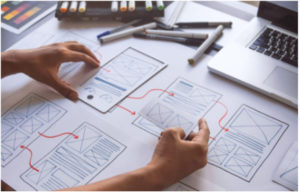A Look Into A Corkboard Creative’s Design Process
So you’ve hired a Corkboard Creative Specialist to create branded marketing materials, but you are unsure about what Designers do and what their workflow is like. Although every Creative can have differences in their design process, I’m here to help give you some general insight as to what we do here at Corkboard as Creatives and what to expect when working with one of us.
First off, what is graphic design? According to the American Institute of Graphic Arts (AIGA), graphic design is defined as “the art and practice of planning and projecting ideas and experiences with visual and textual content.” In layman’s terms, graphic design is the practice of composing and arranging the visual elements of a project, while its objective is to convey or enhance a message. Good graphic art streamlines communication and can even elicit an emotional response from the viewer or even motivate them to take action.
So, what is a design process? Designing graphics involves equal parts of “creative” and “process.” Not only does creative ideation and design work fit into this process, but so does a great deal of communication, critical thinking, and problem-solving as well. As I have mentioned in the past, design is much more than just pretty pictures and layouts. It is a form of communication between you and your audience that conveys your ideas and who you are as a business, all while maintaining visual aesthetics.
The Creative Design Process in 6 Steps:
This process is broken down into 3 phases to evolve over time.
The Definition Phase:
- Build out the creative brief.
- Conduct design research.
The Creative Phase:
- Brainstorm and refine the design concept.
- Create the design.
The Feedback and Delivery Phase:
- Collect and implement feedback.
- Finalize and deliver the design assets.
1. Build out the creative brief.
Before any of the creative design work can begin, the first step is to establish a creative brief, also known as a design brief. This document sets the tone for the entire project and should capture all of the client’s wants, needs, expectations, and any other key project specifications. The creative brief is supposed to help the Designer understand the scope of the project and what will be needed from them. As a client, it is best to have this prepared when proposing your project to the Designer.
The Designer should also be asking any questions necessary to help flesh out the creative brief where needed. Arguably, this is the most important step in the design process, since the creative brief will lead to the ideation phase in creating a design that meets your requirements. It is ideal to go over the creative brief in a meeting as well since this will help ensure some clarity and avoid any uncertainties either party may have.
Your creative brief should include:
- Company details
- Brand guidelines (also known as brand standards)
- Target audience
- The problem the brand is facing (if there is one)
- What the final product should be (I.e. website, brochure, ad campaigns, etc)
- Timeline expectations and milestones
- Budget
- What do you intend viewers to do when they see the final product
- Examples of similar work you like (and don’t)
If you really want to go the extra mile here are 7 Tips For Better Collaboration With Designers!
2. Conduct design research.
Next, your Designer will begin researching the design ecosystem. Research is an important part of what a designer does. Through researching, Designers gain design inspiration, and insight as to what is popular among their competitors, and what is engaging to their intended audience.

3. Brainstorm and refine the design concept.
After gathering all of the vital knowledge they would need from the creative brief and through research, your Designer will begin brainstorming ideas. This can entail drawing up thumbnail sketches, creating mood boards, and piecing together potential design elements in rough mockups. Larger and more significant projects, like logo development and web design that has multiple pages, may require more fine-tuning and several iterations before moving into production.
Your Designer may contact you to ask for feedback about their overall approach to the design work, to see if any key elements are missing or if items should be tweaked. This process helps both the client and the Designer from wasting any energy and time designing down the wrong path.

4. Create the design.
Once everyone is in agreement with the design concept, the Designer will move on to executing the project. Throughout this process, the Designer will implement any knowledge and feedback they gained through the previous steps, along with industry best practices, and technical design skills. This is the stage where the design really starts to come together and more polished design elements are added or created.
5. Collect and implement feedback.
After the design work is completed, we now enter the feedback and delivery stage. At this point, the Designer will share the finished design with the client. This is when any questions, concerns, additional details, and feedback are discussed between both parties. Throughout this stage, the Designer may make several revisions and then repeat the process of discussion over again as needed.

6. Finalize and deliver the design assets.
Yay! We’ve come to the last stage of the creative design process! At this point, the design is finalized and the completed files are put into action.
Ending Note
Now that we’ve come to the end of a Corkboard Creative’s design process, I hope this helped give you a better understanding of what we do and open the door to better and easier communication when going over new projects.
Check out some of our other blogs for more awesome inspiration and knowledge for Creatives. Here are some recommendations to get you started!
Branding:
3 Tips for Better Usage of Your Brand’s Creative
Design:
To Follow Design Trends Or Not





